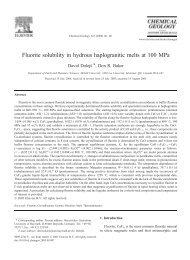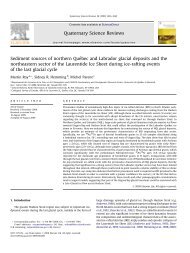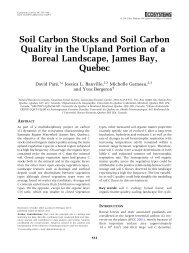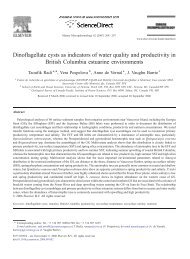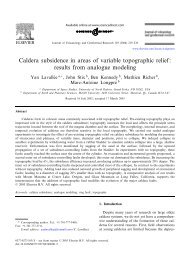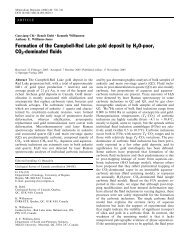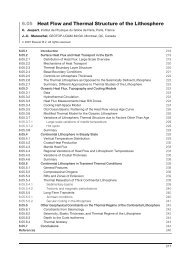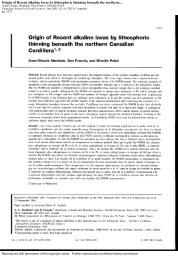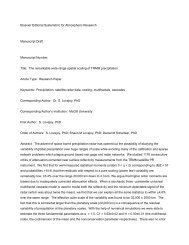A pervasive link between Antarctic ice core and subarctic Pacific ...
A pervasive link between Antarctic ice core and subarctic Pacific ...
A pervasive link between Antarctic ice core and subarctic Pacific ...
Create successful ePaper yourself
Turn your PDF publications into a flip-book with our unique Google optimized e-Paper software.
Quaternary Science Reviews 29 (2010) 206–212<br />
Contents lists available at ScienceDirect<br />
Quaternary Science Reviews<br />
journal homepage: www.elsevier.com/locate/quascirev<br />
A <strong>pervasive</strong> <strong>link</strong> <strong>between</strong> <strong>Antarctic</strong> <strong>ice</strong> <strong>core</strong> <strong>and</strong> <strong>subarctic</strong> <strong>Pacific</strong> sediment records<br />
over the past 800 kyrs<br />
S.L. Jaccard a, *, E.D. Galbraith b , D.M. Sigman c , G.H. Haug a,d<br />
a Geological Institute, ETH Zurich, Zurich, Switzerl<strong>and</strong><br />
b Earth <strong>and</strong> Planetary Science, McGill University, Montreal, Canada<br />
c Department of Geosciences, Princeton University, Princeton, NJ, USA<br />
d Leibniz Center for Earth Surface <strong>and</strong> Climate Studies, Institute for Geosciences Potsdam University, 14476 Potsdam, Germany<br />
article<br />
info<br />
abstract<br />
Article history:<br />
Received 23 January 2009<br />
Received in revised form<br />
24 August 2009<br />
Accepted 11 October 2009<br />
Recently developed XRF <strong>core</strong>-scanning methods permit paleoceanographic reconstructions on timescales<br />
similar to those of <strong>ice</strong>-<strong>core</strong> records. We have investigated the distribution of biogenic barium (Ba/<br />
Al), opal <strong>and</strong> carbonate (Ca/Al) in a sediment <strong>core</strong> retrieved from the abyssal <strong>subarctic</strong> <strong>Pacific</strong> (ODP 882,<br />
50 N, 167 E, 3244 m) over an interval that spans the full length of the EPICA Dome C (EDC) <strong>ice</strong>-<strong>core</strong><br />
record. Ba/Al <strong>and</strong> biogenic opal show a strong resemblance to the EDC dD <strong>and</strong> CO 2 , with generally high<br />
concentrations during interglacials <strong>and</strong> lower values during <strong>ice</strong> ages of the past 800 kyrs. The sedimentary<br />
Ba/Al <strong>and</strong> biogenic opal are most easily interpreted as indicating a reduced sinking flux of<br />
organic matter from the surface ocean during cold periods. The Ba/Al maxima during peak interglacials<br />
are accompanied by transient Ca/Al peaks in these otherwise carbonate-devoid sediments, which are<br />
best explained by a deepening of the calcite lysocline, presumably due to reduced storage of respired CO 2<br />
in the deep North <strong>Pacific</strong>. For most of the ‘‘luke-warm’’ interglacials noted <strong>between</strong> 420 <strong>and</strong> 750 ka in<br />
EDC, the Ba/Al peaks in ODP 882 are also lower, further strengthening the evidence for a simple physical<br />
<strong>link</strong> <strong>between</strong> global climate <strong>and</strong> the biogeochemistry of the <strong>subarctic</strong> <strong>Pacific</strong>.<br />
Ó 2009 Elsevier Ltd. All rights reserved.<br />
1. Introduction<br />
Air bubbles encapsulated in <strong>Antarctic</strong> <strong>ice</strong> reveal that past atmospheric<br />
carbon dioxide concentrations (pCO 2 ) varied cyclically from<br />
low values (w160–180 ppmv) during <strong>ice</strong> ages to higher values<br />
(w280–300 ppmv) during interglacials over the past 800 kyrs (Lüthi<br />
et al., 2008; Monnin et al., 2001; Petit et al.,1999; Siegenthaler et al.,<br />
2005), exhibiting a strong stationary relationship with changes in<br />
<strong>Antarctic</strong> air temperatures (Jouzel et al., 2007). While the transition<br />
from warm to cold periods was generally progressive, temperature<br />
<strong>and</strong> CO 2 increase during glacial terminations was relatively abrupt.<br />
Since the deep ocean stores 25 times more CO 2 than the atmosphere<br />
<strong>and</strong> surface ocean combined, it seems inescapable that changes in<br />
the ocean carbon cycle played a significant role in modulating <strong>and</strong><br />
controlling past variations of atmospheric CO 2 , which in turn<br />
amplified climate forcings to yield the large observed amplitude of<br />
<strong>ice</strong> age cycles (e.g. Broecker, 1982; Sigman <strong>and</strong> Boyle, 2000). Abyssal<br />
water is ventilated on a multi-centennial to millennial timescale, so<br />
that a change in atmospheric CO 2 driven by factors other than<br />
oceanic processes would be dampened. In addition, over thous<strong>and</strong>s<br />
* Corresponding author.<br />
E-mail address: samuel.jaccard@erdw.ethz.ch (S.L. Jaccard).<br />
of years, the deep ocean regulates the exchange of inorganic carbon<br />
<strong>between</strong> the geological reservoir <strong>and</strong> the hydrosphere/atmosphere<br />
system through its control of the burial of calcium carbonate on the<br />
seafloor (Sigman <strong>and</strong> Boyle, 2000).<br />
1.1. Efficiency of the biological pump <strong>and</strong> ocean-atmosphere<br />
CO 2 exchange<br />
The warm sunlit surface ocean layer is separated by a strong<br />
temperature-driven density gradient (thermocline) from the cold<br />
deep ocean, preventing rapid communication <strong>between</strong> the lowlatitude<br />
ocean surface <strong>and</strong> the ocean interior. As a result, nutrients<br />
transferred to the deep via the remineralization of sinking organic<br />
matter are not readily returned to the photic zone, <strong>and</strong> phytoplankton<br />
completely exhaust roughly 2/3 of global ocean surface<br />
waters of available nutrients on a seasonal basis (Conkright et al.,<br />
2002). In tropical <strong>and</strong> subtropical regions of the world ocean,<br />
a large fraction of the nutrient resupply to the euphotic zone occurs<br />
via Subantarctic Mode Water, which spreads throughout the entire<br />
Southern Hemisphere <strong>and</strong> North Atlantic Ocean (e.g. Sarmiento<br />
et al., 2004, 2007). The fact that nutrients are completely consumed<br />
throughout the low-latitude surface ocean means that the biological<br />
pump is at maximum efficiency there.<br />
0277-3791/$ – see front matter Ó 2009 Elsevier Ltd. All rights reserved.<br />
doi:10.1016/j.quascirev.2009.10.007
S.L. Jaccard et al. / Quaternary Science Reviews 29 (2010) 206–212 207<br />
In contrast, dense waters are exposed at the surface of highlatitude<br />
oceans, such as the <strong>subarctic</strong> <strong>Pacific</strong> (Gargett, 1991; Talley,<br />
1995) <strong>and</strong> the Southern Ocean (Sarmiento et al., 2004), <strong>and</strong> are<br />
returned to the subsurface before the available nutrients are fully<br />
utilized by phytoplankton for carbon fixation (Sarmiento <strong>and</strong><br />
Toggweiler, 1984; Sigman <strong>and</strong> Boyle, 2000). The exposure of<br />
nutrient-rich deep water at the surface fuels phytoplankton<br />
growth, but simultaneously it allows CO 2 previously sequestered by<br />
the biological pump to be released to the atmosphere. The uptake of<br />
nutrients <strong>and</strong> CO 2 during formation of phytoplankton biomass<br />
through photosynthesis <strong>and</strong> the eventual export of organic matter<br />
subsequently lowers the pCO 2 of surface waters, causing the surface<br />
layer to reabsorb a portion of the CO 2 that was initially released<br />
from the upwelled water. However, any unused nutrients that are<br />
physically pumped back into the ocean interior as ‘preformed’<br />
nutrients represent a shortfall in the potential efficiency of the<br />
biological pump (Sigman <strong>and</strong> Haug, 2003; Ito <strong>and</strong> Follows, 2005)<br />
Thus, it is the ratio <strong>between</strong> export production <strong>and</strong> the ventilation<br />
rate of CO 2 -rich subsurface waters (not the absolute rate of either<br />
process alone) that controls the net exchange of CO 2 <strong>between</strong> the<br />
atmosphere <strong>and</strong> the high-latitude surface ocean (Sarmiento <strong>and</strong><br />
Toggweiler, 1984). As a result, either increased export flux <strong>and</strong>/or<br />
reduced communication <strong>between</strong> the subsurface ocean <strong>and</strong> the<br />
atmosphere would contribute to sequester a larger proportion of<br />
CO 2 in the ocean during <strong>ice</strong> ages, thereby contributing to reduce<br />
atmospheric CO 2 concentrations (Stephens <strong>and</strong> Keeling, 2000;<br />
Sarmiento <strong>and</strong> Toggweiler, 1984; Siegenthaler <strong>and</strong> Wenk, 1984;<br />
Sigman <strong>and</strong> Boyle, 2000).<br />
1.2. The <strong>subarctic</strong> NW <strong>Pacific</strong> – past <strong>and</strong> present<br />
The <strong>subarctic</strong> <strong>Pacific</strong> is one of the three major high nutrient low<br />
chlorophyll (HNLC) regions of the world ocean, characterized by<br />
upwelling of nutrient-rich deep water into the euphotic zone due to<br />
Ekman divergence (Gargett, 1991). Low ambient iron concentrations<br />
limit complete utilization of available dissolved nutrients <strong>and</strong><br />
growth of large celled phytoplankton (Tsuda et al., 2003). Macronutrient<br />
supply to the photic zone is moderated by the strength of<br />
the permanent salinity-driven density gradient (halocline) that<br />
dominates the region today. The presence of this low-salinity<br />
surface layer prevents thorough convection; hence no deep water is<br />
formed today in the open <strong>subarctic</strong> <strong>Pacific</strong> (Emile-Geay et al., 2003;<br />
Warren, 1983). In addition, the relatively effective isolation of the<br />
subtropical <strong>and</strong> <strong>subarctic</strong> gyres minimizes dilution of the high<br />
nutrient water by nutrient-depleted waters from lower latitudes. In<br />
spite of rather limited mixing <strong>between</strong> mid-depths <strong>and</strong> the surface<br />
ocean, the modern <strong>subarctic</strong> <strong>Pacific</strong> still constitutes a source of<br />
oceanic CO 2 to the atmosphere (Takahashi et al., 2002) despite the<br />
anthropogenically-elevated atmospheric partial pressure of CO 2 .<br />
Primary productivity is dominated by sil<strong>ice</strong>ous algae (diatoms) in<br />
early summer <strong>and</strong> to a lesser degree by calcareous phytoplankton<br />
early autumn when silicic acid concentrations have dropped.<br />
Sediment trap observations have shown that total mass flux <strong>and</strong><br />
biogenic opal flux are highly correlated (Honda et al., 2002), suggesting<br />
that opal is the main export vector for organic carbon<br />
(Otosaka <strong>and</strong> Noriki, 2005). At station KNOT (44 N, 150 E), the<br />
transfer efficiency of organic carbon (i.e. the ratio <strong>between</strong> organic<br />
carbon flux to primary productivity) was estimated to be approx.<br />
3% at 3000 m water depth, a value that is substantially higher than<br />
observed elsewhere in the world ocean (Honda et al., 2002).<br />
There seems to be a general consensus, that export production<br />
in the NW <strong>subarctic</strong> <strong>Pacific</strong> was significantly lower during peak <strong>ice</strong><br />
ages when compared to interglacial periods (Brunelle et al., 2007;<br />
Galbraith et al., 2008; Gebhardt et al., 2008; Kienast et al., 2004;<br />
Jaccard et al., 2005, 2009; Narita et al., 2002; Shigemitsu et al.,<br />
2007), suggesting that nutrient supply from below was reduced<br />
during cold periods. A corollary to these observations is that the<br />
physical transfer of deeply sequestered CO 2 to the surface ocean<br />
through upwelling <strong>and</strong> turbulent mixing would have been reduced<br />
during <strong>ice</strong> ages, thereby contributing to lower global atmospheric<br />
CO 2 concentrations.<br />
In this manuscript, we present new high-resolution measurements<br />
from a sedimentary archive retrieved from the abyssal NW<br />
<strong>subarctic</strong> <strong>Pacific</strong> Ocean. The time resolution achieved here rivals the<br />
measurement density typical for <strong>Antarctic</strong> <strong>ice</strong>-<strong>core</strong> records. We<br />
build upon previous observations (Galbraith et al., 2008; Jaccard<br />
et al., 2005, 2009) by extending the Ba/Al, Ca/Al <strong>and</strong> biogenic opal<br />
records back to 800 kyr to allow comparison with EPICA Dome C<br />
(EDC) records. Our multi-proxy approach reveals that export<br />
production <strong>and</strong> thus the nutrient supply to the surface is <strong>link</strong>ed to<br />
<strong>Antarctic</strong> dD <strong>and</strong> CO 2 records on millennial timescales, suggesting<br />
a strong physical <strong>link</strong> <strong>between</strong> temperature in high southern latitudes<br />
<strong>and</strong> the nutrient supply to the <strong>subarctic</strong> <strong>Pacific</strong> photic zone.<br />
Our reconstructions further document the contribution the<br />
<strong>subarctic</strong> <strong>Pacific</strong> made to modulate the partitioning of CO 2 <strong>between</strong><br />
the abyssal ocean <strong>and</strong> the atmosphere on glacial-interglacial<br />
timescales.<br />
2. Material, methods & proxies<br />
2.1. Core material<br />
ODP Site 882 is located in the <strong>subarctic</strong> NW <strong>Pacific</strong> (Detroit<br />
Seamount, 50 21 0 N, 167 35 0 E; water depth 3244 m). The <strong>core</strong><br />
contains undisturbed diatomaceous ooze sequences with episodic<br />
carbonate-rich intervals <strong>and</strong> scattered ash layers (Rea et al., 1993).<br />
The astronomically calibrated stratigraphy for ODP Site 882 was<br />
generated based on fine tuning of GRAPE (Gamma Ray Attenuation<br />
Porosity Evaluator) density oscillations in the orbital precession<br />
b<strong>and</strong> to the summer insolation at 65 N(Tiedemann <strong>and</strong> Haug,<br />
1995). In addition, benthic foraminiferal oxygen isotope records<br />
from ODP Sites 882 <strong>and</strong> 883 (cross-correlated with magnetic<br />
susceptibility) in intervals with CaCO 3 were used to corroborate the<br />
tuned stratigraphy. The age model was linearly interpolated<br />
<strong>between</strong> the selected tie-points. To derive the detailed age model<br />
we then fine-tuned the ODP Site 882 Ba/Al record to the EDC dD<br />
record (Jouzel et al., 2007) by visually matching common inflection<br />
points <strong>and</strong> interpolating linearly <strong>between</strong> them (Galbraith et al.,<br />
2008; Jaccard et al., 2005). This approach assumes a strict in-phase<br />
relationship <strong>between</strong> EDC dD <strong>and</strong> ODP 882 Ba/Al records, which is<br />
unlikely to be true, <strong>and</strong> therefore introduces some degree of<br />
uncertainty. Bioturbation in these oxic sediments is in the order of<br />
a few centimeters, smoothing the records slightly. Sedimentation<br />
rates typically range <strong>between</strong> 5 <strong>and</strong> 10 cm*kyr 1 .<br />
2.2. Analytical methods<br />
Relative sedimentary elemental concentrations (Al, Ca, Ba) were<br />
measured with an Aavatech profiling X-ray Fluorescence (XRF) <strong>core</strong><br />
scanner at Bremen University at a 1–3 cm (i.e. submillenial) resolution.<br />
The calculations of normative Ba/Al <strong>and</strong> Ca/Al are based on<br />
the assumption that the Al, Ba <strong>and</strong> Ca content of the terrigenous<br />
material remained constant in space <strong>and</strong> time. Comparison<br />
<strong>between</strong> discrete ICP-MS <strong>and</strong> coulometric determination of sedimentary<br />
CaCO 3 <strong>and</strong> relative Ba/Al <strong>and</strong> Ca/Al counts, respectively,<br />
has shown a highly significant statistical correlation (Jaccard et al.,<br />
2009; Suppl. Fig.). Biogenic opal was quantified by alkaline<br />
extraction of silica (Mortlock <strong>and</strong> Froelich, 1989) for the time<br />
interval back to 150 kyr (Jaccard et al., 2009) <strong>and</strong> with help of the<br />
density separation technique on carbonate- <strong>and</strong> organic carbon-
208<br />
S.L. Jaccard et al. / Quaternary Science Reviews 29 (2010) 206–212<br />
free sediments (Haug et al., 1995) for the rest of the investigated<br />
interval. Replicate measurements indicate a general reproducibility<br />
of about 3–5% depending on the sedimentary opal content.<br />
2.3. Proxies<br />
All proxies used to reconstruct past variability of export<br />
production are subject to potential biases. A multi-proxy approach<br />
may thus help to compensate for specific limitations associated<br />
with individual proxies, assuming the proxy biases are independent<br />
of each other. Biogenic (or excess) barite (bioBa) precipitates<br />
from seawater, <strong>and</strong> its flux to the seafloor is correlated with integrated<br />
export production (Goldberg <strong>and</strong> Arrhenius, 1958; Dymond<br />
et al., 1992). Biogenic barite formation is thought to take place<br />
through indirect biological mediation <strong>and</strong> abiotic precipitation<br />
from supersaturated microenvironments within settling biogenic<br />
particles (Ganeshram et al., 2003) <strong>and</strong> may therefore represent<br />
a proxy for integrated organic carbon export from the photic zone<br />
(Eagle et al., 2003; François et al., 1995). BioBa dissolves under<br />
conditions of sulfate depletion by microbial sulfate reduction<br />
(McManus et al., 1998; Paytan <strong>and</strong> Kastner, 1996), which is mainly<br />
restricted to highly productive coastal areas <strong>and</strong> the equatorial<br />
<strong>Pacific</strong> upwelling system. We note that in these highly productive<br />
regimes, where sedimentation rates <strong>and</strong> organic carbon export<br />
fluxes are significantly higher than in the <strong>subarctic</strong> <strong>Pacific</strong>, barite<br />
dissolution has been observed under suboxic conditions,<br />
precluding its application as a quantitative proxy to reconstruct<br />
past changes in export production (McManus et al., 1998). Although<br />
most of the ocean is undersaturated with respect to barite (Monnin<br />
et al., 1999), a significant fraction of the bioBa produced in the<br />
water-column is preserved in sediments under oxic/suboxic<br />
conditions typical of pelagic environments (Dymond et al., 1992;<br />
Paytan <strong>and</strong> Kastner, 1996; Paytan <strong>and</strong> Griffith, 2007). Approximately<br />
30% of the barite precipitated during settling is preserved in<br />
the sediment, whereas only 5 ky does not appear to hold at finer<br />
temporal scales, such as during the last deglaciation (Galbraith<br />
et al., 2007; Gebhardt et al., 2008; Kiefer et al., 2001; Sarnthein<br />
et al., 2006). Ca/Al shows a bimodal distribution, with carbonatefree<br />
sediments interrupted by apparent calcite preservation spikes<br />
that occur at each glacial termination but also appear to persist into<br />
roughly the first half of the following interglacial period. Ba/Al,<br />
biogenic opal <strong>and</strong> Ca/Al show good correlations with <strong>Antarctic</strong> <strong>ice</strong><strong>core</strong><br />
dD <strong>and</strong> CO 2 records (Fig. 2) both in terms of frequency <strong>and</strong><br />
(cps)<br />
Ca/Al<br />
(cps)<br />
Ba/Al<br />
200<br />
150<br />
100<br />
50<br />
0<br />
b<br />
2 4 6 8 10 12<br />
ODP 882<br />
MD2416<br />
10<br />
5.5<br />
0<br />
5.0 d<br />
4.5<br />
4.0<br />
3.5<br />
3.0<br />
2.5<br />
2.0<br />
1.5<br />
0 100 200 300 400 500 600 700 800<br />
Age (kyr)<br />
R el. NO utilizatio n<br />
3<br />
14 16 18<br />
Fig. 1. Reconstructions of past changes in surface ocean fertility, calcium carbonate preservation in the sediment <strong>and</strong> nutrient dynamics at ODP site 882 across the past 800 kyrs.<br />
(a) Residual (i.e. the fraction of the signal related to the degree of nitrate utilization by phytoplankton) bulk sediment d 15 N at site ODP 882 (black) <strong>and</strong> nearby <strong>core</strong> MD2416<br />
(dark grey) (Galbraith et al., 2008). (b) Ca/Al (data smoothed by a five-point running mean), (c) biogenic opal, (d) Ba/Al (data smoothed by a five-point running mean). Grey bars are<br />
indicative of glacial maxima. Marine Isotope Stages (MIS) are given in Arabic numerals.<br />
a<br />
c<br />
-3<br />
-2<br />
-1<br />
0<br />
1<br />
2<br />
3<br />
60<br />
50<br />
40<br />
30<br />
20<br />
δ<br />
1 5 N s<br />
r e<br />
(‰ vsAIR )<br />
biogenic opal (wt%)
S.L. Jaccard et al. / Quaternary Science Reviews 29 (2010) 206–212 209<br />
amplitude (Fig. 3) of the signal. Ba/Al <strong>and</strong>, to a lesser degree, Ca/Al<br />
show a generally lower amplitude <strong>between</strong> 450 <strong>and</strong> 750 kyrs<br />
during the ‘‘luke-warm’’ interglacials, MIS 13, 15 & 17 (Figs. 3 <strong>and</strong> 4).<br />
In particular, interglacial maxima show significantly lower values<br />
when compared to the past 450 kyr, the glacial baseline remaining<br />
rather constant across the entire record (Fig. 2). We note, however,<br />
that the correlation <strong>between</strong> ODP882 Ba/Al <strong>and</strong> EDC dD <strong>and</strong> CO2<br />
was markedly weaker prior to 450kyr, for reasons that are currently<br />
unclear. Further investigations will aim to clarify this issue.<br />
4. Discussion<br />
Reconstruction of past changes in organic carbon export is<br />
uncertain, as each proxy has its own biases. Here we analyze two<br />
different proxies, both of which yield a picture that is internally<br />
consistent <strong>and</strong> supported by data from the literature (see above). It<br />
is important to point out that the concentrations of both organic<br />
carbon <strong>and</strong> chlorins (an algal biomarker) are higher in glacial age<br />
sediments, in contrast to the bioBa <strong>and</strong> opal (Gebhardt et al., 2008;<br />
Gorbarenko, 1996; Haug et al., 1995; Kiefer et al., 2001; Shigemitsu<br />
et al., 2007). These organic phases might seem to be more direct<br />
proxies of carbon export than the mineral proxies we present here.<br />
However, the maximum chlorin concentrations observed in <strong>core</strong><br />
MD01-2416 (Gebhardt et al., 2008), gradually decrease down<strong>core</strong><br />
with values up to 10 000 ng/g for TERM I to 20 mM)<br />
(Pedersen <strong>and</strong> Ingram, 1995). We therefore assume here that the<br />
less direct, but hopefully more robust mineral proxies are the most<br />
accurate reflection of past changes in export production, with the<br />
caveat that the causes of higher glacial concentrations of organic<br />
components should be more thoroughly investigated.<br />
Shigemitsu et al. (2007) recently presented a novel approach to<br />
address past changes in the dust flux to the western <strong>subarctic</strong><br />
<strong>Pacific</strong>. Their results show that the eolain contribution to the<br />
sediment was approximately tw<strong>ice</strong> as high during the past <strong>ice</strong> ages<br />
when compared to interglacials. Preliminary results, based on 232 Th<br />
MAR (Jaccard et al., 2009) seem to support their conclusion. As<br />
a result, a portion of the Ba/Al signal is likely to reflect the enhanced<br />
input of eolian material during glacial intervals. However, 230Thnormalized<br />
flux reconstructions for TERM I (Jaccard et al., 2009)<br />
clearly confirm that the last deglaciation was marked by a large<br />
increase in the preserved flux of biogenic detritus, accompanying<br />
the inferred decrease in dust supply.<br />
Reconstructions of sea surface temperature from alkenones<br />
(Haug, 1996), foraminiferal Mg/Ca (Gebhardt et al., 2008), <strong>and</strong><br />
foraminiferal transfer functions (Kiefer et al., 2001; Kiefer <strong>and</strong><br />
Kienast, 2005) all indicate that, even during the coldest times,<br />
summertime SST never approached freezing in the vicinity of the<br />
<strong>core</strong> site. This corroborates micropaleontological evidence that ODP<br />
Site 882 is located well east of the maximum perennial sea-<strong>ice</strong><br />
extent over the Pleistocene (Climap Members, 1981) (Sancetta <strong>and</strong><br />
Silvestri, 1986). As a result, sea <strong>ice</strong> cover is unlikely to have represented<br />
a major limitation on the spring/summer growing season<br />
during glacial times. Rather, some other factor must have limited<br />
phytoplankton growth during glacial times. The aeolian dust supply<br />
(cps)<br />
Ba/Al<br />
D‰ ( vsSMOW )<br />
δ<br />
5.5<br />
5.0<br />
4.5<br />
4.0<br />
3.5<br />
3.0<br />
2.5<br />
2.0<br />
1.5<br />
-360<br />
-380<br />
-400<br />
-420<br />
-440<br />
T V<br />
T IV<br />
T VIII<br />
T VII<br />
TI T T III<br />
T IX<br />
II<br />
T VI<br />
b<br />
d<br />
a<br />
c<br />
200<br />
150<br />
100<br />
50<br />
0<br />
300<br />
280<br />
260<br />
240<br />
220<br />
200<br />
180<br />
160<br />
Ca/Al (cps)<br />
C O (ppmv )<br />
2<br />
-460<br />
0 100 200 300 400 500 600 700 800<br />
Age (kyr)<br />
Fig. 2. (a) Ca/Al <strong>and</strong> (b) Ba/Al records from ODP site 882 compared to (c) EDC CO 2 (Lüthi et al., 2008) (Monnin et al., 2001) (Siegenthaler et al., 2005) <strong>and</strong> (d) the deuterium (dD)<br />
(Jouzel et al., 2007) records during the past 800 kyrs. Glacial Terminations are indicated using Roman numerals in subscript.
210<br />
S.L. Jaccard et al. / Quaternary Science Reviews 29 (2010) 206–212<br />
1.5<br />
Normalized Amplitude<br />
1.0<br />
0.5<br />
CO 2<br />
δD<br />
Ba/Al<br />
0<br />
T I<br />
T II<br />
T III<br />
T IV<br />
T V<br />
T VI<br />
T VII<br />
T VIII<br />
T IX<br />
Fig. 3. Interglacial-glacial CO 2 (dark grey), dD (light grey) <strong>and</strong> Ba/Al (red) amplitude for glacial terminations I-VII. Amplitude is (arbitrarily) defined as the difference <strong>between</strong> the<br />
three consecutive highest interglacial values <strong>and</strong> the three consecutive lowest values preceding the onset of glacial terminations. The amplitude of each parameter has been<br />
normalized to TERM 1 values.<br />
of iron to the region was, if anything, higher during colder times<br />
(Kienast et al., 2004; Shigemitsu et al., 2007). It is still possible that<br />
some other physical change, such as a deeper summertime mixed<br />
layer, led to greater light limitation during <strong>ice</strong> ages (e.g. Anderson<br />
et al., 2002). Alternatively, reduced upwelling or vertical mixing<br />
may have decreased the supply from below of both iron <strong>and</strong> the<br />
major nutrients. In this case, the increased supply of iron from<br />
above must have failed to compensate for the reduced supply from<br />
below, leading to the net decrease in productivity. Nevertheless,<br />
this situation should result in more complete major nutrient<br />
consumption, because of the greater proportional importance of<br />
the iron input from above. Indeed, <strong>subarctic</strong> northwest <strong>Pacific</strong><br />
sediment <strong>and</strong> diatom-bound d 15 N – a measure of the relative<br />
utilization of dissolved nitrate (Altabet <strong>and</strong> François, 1994) – shows<br />
a strong negative correlation with export production on >5ky<br />
timescales (Brunelle et al., 2007; Galbraith et al., 2008; Nakatsuka<br />
et al., 1995)(Fig. 1 panel (a)). This suggests that, during <strong>ice</strong> ages, the<br />
relative amount of nitrate that was utilized by phytoplankton<br />
increased, even though the absolute rate of nitrate consumption<br />
decreased, which implies that the supply of nutrients to the<br />
<strong>subarctic</strong> North <strong>Pacific</strong> was reduced during <strong>ice</strong> ages. The N isotope<br />
data in themselves suggest that the efficiency of the <strong>subarctic</strong><br />
<strong>Pacific</strong> biological pump increased during <strong>ice</strong> ages, thereby<br />
contributing to sequester a larger burden of remineralized carbon<br />
into the abyssal ocean (Brunelle et al., 2007; Galbraith et al., 2008).<br />
Enhanced glacial storage of metabolic carbon would have reduced<br />
oxygenation of the abyssal ocean, consistent with other data, such<br />
as authigenic Uranium content (Galbraith et al., 2007; Jaccard et al.,<br />
2009; Shigemitsu et al., 2007). Similarly, d 15 N records from the<br />
<strong>Antarctic</strong> Zone of the Southern Ocean indicate higher relative<br />
nitrate utilization <strong>and</strong> yet reduced export production during peak<br />
<strong>ice</strong> ages (François et al., 1997; Robinson et al., 2004; Robinson <strong>and</strong><br />
Sigman, 2008; Schneider-Mor et al., 2005), suggesting that either<br />
a common physical mechanism modulated the nutrient supply of<br />
both these polar regions in t<strong>and</strong>em (Sigman et al., 2004), or that<br />
a physical change in the Southern Ocean controlled the <strong>subarctic</strong><br />
<strong>Pacific</strong> nutrient budget remotely.<br />
Biogenic carbonate (Ca/Al), which was nearly or completely<br />
absent in these <strong>core</strong>s throughout much of the glacial sediments,<br />
suddenly appears in abundance at each glacial termination.<br />
Although the increase in CaCO 3 concentration may reflect<br />
enhanced local CaCO 3 export, the rapid increase suggests a rapid<br />
deepening of the lysocline, driven by a decrease of DIC <strong>and</strong>/or<br />
an increase in the alkalinity of bottom waters at times when<br />
deeply sequestered CO 2 is released to (sub)surface waters. If<br />
these intervals were solely deglacial, then they could be taken as<br />
indicative of the global preservation event that one would<br />
predict at the end of <strong>ice</strong> ages, when CO 2 is released from the<br />
ocean to accumulate in the atmosphere <strong>and</strong> terrestrial biosphere<br />
(e.g. Broecker <strong>and</strong> Peng, 1985; Marchitto et al., 2005). However,<br />
high Ca/Al tends to persist into interglacials, suggesting that at<br />
least in the early part of interglacials, the <strong>subarctic</strong> North <strong>Pacific</strong><br />
interior had a smaller burden of regenerated dissolved inorganic<br />
carbon, due either to ventilation from the South <strong>and</strong>/or locally<br />
interglacial-glacial δD ampl.<br />
(‰ vs SMOW)<br />
80<br />
70<br />
60<br />
50<br />
40<br />
T III<br />
T VII<br />
T IV<br />
T V<br />
T IX<br />
30 T VIII<br />
20<br />
T VI R = 0.92<br />
10<br />
30 40 50 60 70 80 90 100<br />
interglacial- glacial CO 2<br />
ampl. (ppmv)<br />
T I<br />
T II<br />
interglacial-glacial δD ampl.<br />
(‰ vs SMOW)<br />
80<br />
70<br />
60<br />
50<br />
40<br />
30<br />
T VII<br />
T III<br />
T I<br />
T VIII<br />
T VI<br />
T IV<br />
T V<br />
T II<br />
T IX<br />
20<br />
R = 0.82<br />
10<br />
1.0 1.5 2.0 2.5 3.0 3.5<br />
interglacial-glacial Ba/Al ampl .<br />
interglacial-glacial CO 2<br />
ampl.<br />
(ppmv)<br />
100<br />
90<br />
80<br />
70<br />
T VII<br />
T IV<br />
T V<br />
T II<br />
T III<br />
T I<br />
T IX<br />
60<br />
T<br />
50<br />
VIII<br />
40<br />
T R = 0.76<br />
VI<br />
30<br />
1.0 1.5 2.0 2.5 3.0 3.5<br />
interglacial-glacial Ba/Al ampl .<br />
Fig. 4. Cross-plots illustrating the correlation <strong>between</strong> (a) dD <strong>and</strong> CO 2 amplitude; (b) dD <strong>and</strong> Ba/Al amplitude; (c) Ba/Al <strong>and</strong> CO 2 amplitude. Amplitude has been determined as the<br />
difference <strong>between</strong> the three consecutive highest interglacial values <strong>and</strong> the three consecutive lowest values preceding the onset of glacial terminations. R represents the linear<br />
correlation factor <strong>between</strong> variables. Glacial Terminations are indicated using Roman numerals in subscript.
S.L. Jaccard et al. / Quaternary Science Reviews 29 (2010) 206–212 211<br />
by the Subarctic North <strong>Pacific</strong> (Jaccard et al., 2005; Gebhardt<br />
et al., 2008).<br />
The extended ODP 882 Ba/Al record shows reduced amplitude<br />
of interglacial maxima during MIS 13–17, that is reminiscent of the<br />
reduction in amplitude of the dD <strong>and</strong> CO 2 records (Fig. 2). Interglacial-glacial<br />
amplitude variability in the EDC dD, CO 2 <strong>and</strong> ODP<br />
882 Ba/Al records show strong correlations (Fig. 4), further<br />
emphasizing that <strong>Antarctic</strong> air temperature, global atmospheric<br />
CO 2 <strong>and</strong> <strong>subarctic</strong> <strong>Pacific</strong> export production are mechanistically<br />
<strong>link</strong>ed. The apparent implication is that whatever caused the luke<br />
warm interglacials to be relatively cool was <strong>link</strong>ed to marine<br />
biogeochemistry in a roughly linear fashion. Presumably this<br />
resulted from some combination of two things: (1) a straightforward<br />
physical climate control of the marine ecosystem, likely<br />
through modulation of the nutrient supply, or (2) to a straightforward<br />
oceanic control on climate, such as through modulation of<br />
atmospheric CO 2 . For example, given the significant dependency of<br />
polar ocean water-column stability on the mean ocean temperature<br />
(de Boer et al., 2007; Winton, 1997), upwelling of nutrient-rich<br />
deep waters to the <strong>subarctic</strong> <strong>Pacific</strong> (<strong>and</strong> possibly to the <strong>Antarctic</strong><br />
Zone of the Southern Ocean) surface waters could have been<br />
reduced as a direct result of ocean temperature. Wind-driven<br />
mechanisms are also being considered as an explanation for the<br />
reduced <strong>Antarctic</strong> <strong>and</strong> Subarctic North <strong>Pacific</strong> vertical exchange<br />
during <strong>ice</strong> ages (Toggweiler et al., 2006). It remains to be seen<br />
whether such mechanisms could similarly explain the ‘‘mid-way’’<br />
state of North <strong>Pacific</strong> export production during the ‘‘luke-warm’’<br />
interglacials.<br />
5. Conclusion<br />
Sedimentary measurements of Ba/Al from the NW <strong>subarctic</strong><br />
<strong>Pacific</strong> show a <strong>pervasive</strong> <strong>link</strong> to <strong>Antarctic</strong> <strong>ice</strong>-<strong>core</strong> dD (Jouzel et al.,<br />
2007) <strong>and</strong> CO 2 records (Lüthi et al., 2008; Monnin et al., 2001; Petit<br />
et al., 1999; Siegenthaler et al., 2005). The compelling decrease in<br />
amplitude observed in EDC dD, CO 2 <strong>and</strong> ODP 882 Ba/Al during the<br />
‘‘luke-warm’’ interglacials MIS 13, 15 & 17 adds further support for<br />
the apparent climate/North <strong>Pacific</strong> biogeochemistry connection.<br />
Our preferred interpretation is that the export flux from the surface<br />
was significantly reduced during peak <strong>ice</strong> ages when compared to<br />
warmer interglacial intervals, although the preservation of organic<br />
carbon in the seafloor sediments was enhanced during glacials due<br />
to some combination of low temperatures (Matsumoto, 2007), low<br />
oxygen concentrations, <strong>and</strong> high clay concentrations. Increased<br />
dust flux during glacial periods is likely to have further contributed<br />
to low Ba/Al during these intervals. Sea surface temperature<br />
reconstructions (Gebhardt et al., 2008; Haug, 1996; Kiefer et al.,<br />
2001; Kiefer <strong>and</strong> Kienast, 2005) corroborated by micropaleontological<br />
evidence (Sancetta <strong>and</strong> Silvestri, 1986) have shown that the<br />
open <strong>subarctic</strong> <strong>Pacific</strong> was far from freezing during glacial maxima.<br />
Sea <strong>ice</strong> cover is thus unlikely to have represented a major limitation<br />
on the productive season during glacial times. The most reasonable<br />
mechanism for reducing export productivity is a decrease in the<br />
supply of nutrients from subsurface waters. Reconstruction of the<br />
degree of nitrate utilization nitrate using the N isotopes (Brunelle<br />
et al., 2007; Galbraith et al., 2008) suggests that the <strong>subarctic</strong> <strong>Pacific</strong><br />
biological pump was more efficient during <strong>ice</strong> ages. Thus, it may<br />
have contributed significantly to increased deep ocean sequestration<br />
of carbon during <strong>ice</strong> ages.<br />
Acknowledgements<br />
This research used samples provided by the Ocean Drilling<br />
Program (ODP). ODP is sponsored by the U.S. National Science<br />
Foundation (NSF) <strong>and</strong> participating countries under the<br />
management of Joint Oceanographic Institutions (JOI), Inc. We<br />
thank C. Murray-Wallace as well as two anonymous reviewers for<br />
insightful <strong>and</strong> constructive comments.<br />
References<br />
Altabet, M.A., François, R., 1994. Sedimentary nitrogen isotopic ratio as a recorder for<br />
surface ocean nitrate utilization. Global Biogeochemical Cycles 8 (1), 103–116.<br />
Anderson, R.F., Chase, Z., Fleisher, M.Q., Sachs, J.P., 2002. The southern ocean’s<br />
biological pump during the last glacial maximum. Deep-Sea Research II 49,<br />
1909–1938.<br />
Broecker, W.S., 1982. Glacial to interglacial changes in ocean chemistry. Progress in<br />
Oceanography 2, 151–197.<br />
Broecker, W.S., Peng, T.H., 1985. The role of CaCO 3 compensation in the glacial to<br />
interglacial atmospheric CO 2 change. Global Biogeochemical Cycles 1, 15–29.<br />
Brunelle, B.G., et al., 2007. Evidence from diatom-bound nitrogen isotopes for<br />
<strong>subarctic</strong> <strong>Pacific</strong> stratification during the last <strong>ice</strong> age <strong>and</strong> a <strong>link</strong> to North <strong>Pacific</strong><br />
denitrification changes. Paleoceanography 22 doi:1029/2005PA001205.<br />
de Boer, A.M., Sigman, D.M., Toggweiler, J.R., Russell, J.L., 2007. Effect of global ocean<br />
temperature change on deep ocean ventilation. Paleoceanography 22.<br />
doi:10.1029/2005PA001242.<br />
Conkright, M.E., et al., 2002. World Ocean Atlas 2001: Objective Analysis, Data Statistics<br />
<strong>and</strong> Figures, CD-ROM. National Oceanographic Data Center, Silver Spring.<br />
Climap Members, 1981. In: Cline, R. (Ed.), Maps of Northern <strong>and</strong> Southern Hemisphere<br />
Continental Ice, Sea Ice, <strong>and</strong> Sea Surface Temperatures in August for the<br />
Modern <strong>and</strong> the Last Glacial Maximum. Geological Society of America Map <strong>and</strong><br />
Chart Series.<br />
Dymond, J., Suess, E., Lyle, M., 1992. Barium in deep-sea sediments: a geochemical<br />
proxy for paleoproductivity. Paleoceanography 7 (2), 163–181.<br />
Eagle, M., Paytan, A., Arrigo, K.R., van Dijken, G., Murray, R.W., 2003. A comparison<br />
<strong>between</strong> excess barium <strong>and</strong> barite as indicators of carbon export. Paleoceanography<br />
18. doi:10.1029/2002PA000793.<br />
Emile-Geay, J., et al., 2003. Warren revisited: atmospheric freshwater fluxes <strong>and</strong><br />
why is no deep water formed in the North <strong>Pacific</strong>. Journal of Geophysical<br />
Research 108. doi:10.1029/2001JC001058.<br />
François, R., et al., 1997. Contribution of Southern Ocean surface-water stratification<br />
to low atmospheric CO 2 concentrations during the last glacial period. Nature<br />
389, 929–935.<br />
François, R., Honjo, S., Manganini, S.J., Ravizza, G.E., 1995. Biogenic barium to the<br />
deep sea: implications for paleoproductivity reconstruction. Global Biogeochemical<br />
Cycles 9 (2), 289–303.<br />
Galbraith, E.D., et al., 2007. Carbon dioxide release from the North <strong>Pacific</strong> abyss<br />
during the last deglaciation. Nature, 890–894.<br />
Galbraith, E.D., et al., 2008. Consistent relationship <strong>between</strong> global climate <strong>and</strong><br />
surface nitrate utilization in the western Subarctic <strong>Pacific</strong> throughout the last<br />
500 ky. Paleoceanography 23. doi:10.1029/2007PA001518.<br />
Ganeshram, R.S., François, R., Commeau, J., Brown-Leger, S.L., 2003. An experimental<br />
investigation of barite formation in seawater. Geochimica et Cosmochimica Acta<br />
67 (14), 2599–2605.<br />
Gargett, A.E., 1991. Physical processes <strong>and</strong> the maintenance of nutrient-rich<br />
euphotic zones. Limnology <strong>and</strong> Oceanography 36, 1527–1546.<br />
Gebhardt, H., et al., 2008. Paleonutrient <strong>and</strong> productivity records from the <strong>subarctic</strong><br />
North <strong>Pacific</strong> for Pleistocene terminations I to V. Paleoceanography 23.<br />
doi:10.1029/2007PA001513.<br />
Goldberg, E.D., Arrhenius, G.O.S., 1958. Chemistry of <strong>Pacific</strong> pelagic sediments.<br />
Geochimica et Cosmochimica Acta 13, 153–212.<br />
Gorbarenko, S.A., 1996. Stable isotope <strong>and</strong> lithologic evidence of late-glacial <strong>and</strong><br />
holocene oceanography of the northwestern <strong>Pacific</strong> <strong>and</strong> its marginal seas.<br />
Quaternary Research 46, 230–251.<br />
Hartnett, H.E., Keil, R.G., Hedges, J.I., Devol, A.H., 1998. Influence of oxyge exposure<br />
time on organic carbon preservation in continental margin sediments. Nature<br />
391, 572–574.<br />
Haug, G.H., 1996. Zur Paläo-Ozeanographie und Sedimentationsgeschichte im<br />
Nordwest-Pazifik während der letzten 6 Millionen Jahre (ODP-Site 882), p. 78.<br />
Univ. Kiel, Kiel.<br />
Haug, G.H., Maslin, M.A., Sarnthein, M., Stax, R., Tiedemann, R., 1995. Evolution of<br />
northwest <strong>Pacific</strong> sedimentation patterns since 6 Ma (Site 882). In: Rea, D.K.,<br />
Basov, I.A., Scholl, D.W., Allan, J.F. (Eds.), Proceedings of the Ocean Drilling Program.<br />
Scientific Results. Ocean Drilling Program, College Station, TX, pp. 293–314.<br />
Hedges, J.I., et al., 1999. Sedimentary organic matter preservation: a test for selective<br />
degradation under oxic conditions. American Journal of Science 299, 529–555.<br />
Honda, M.C., et al., 2002. The biological pump in the northwestern North <strong>Pacific</strong><br />
based on fluxes <strong>and</strong> major components of particulate matter obtained by<br />
sediment-trap experiments (1997–2000). Deep-Sea Research II 49, 5595–5625.<br />
Ito, T., Follows, M.J., 2005. Preformed phosphate, soft tissue pump <strong>and</strong> atmospheric<br />
CO 2 . Journal of Marine Research 63, 813–839.<br />
Jaccard, S.L., et al., 2009. Subarctic <strong>Pacific</strong> evidence for a glacial deepening of the<br />
oceanic respired carbon pool. Earth <strong>and</strong> Planetary Science Letters 277, 156–165.<br />
Jaccard, S.L., et al., 2005. Glacial/interglacial changes in <strong>subarctic</strong> North <strong>Pacific</strong><br />
stratification. Science 308, 1003–1006.<br />
Jouzel, J., et al., 2007. Orbital <strong>and</strong> millenial antarctic climate variability over the past<br />
800,000 years. Science 317, 793–796.
212<br />
S.L. Jaccard et al. / Quaternary Science Reviews 29 (2010) 206–212<br />
Kiefer, T., Kienast, M., 2005. Patterns of deglacial warming in the <strong>Pacific</strong> ocean:<br />
a review with emphasis on the time interval of heinrich event 1. Quaternary<br />
Science Reviews 24 (7–9), 1063–1081.<br />
Kiefer, T., Sarnthein, M., Erlenkeuser, H., Grootes, M., Roberts, A.P., 2001. North<br />
<strong>Pacific</strong> response to millenial-scale changes in ocean circulation over the last<br />
60 kyr. Paleoceanography 16 (2), 179–189.<br />
Kienast, S.S., Hendy, I.L., Crusius, J., Pedersen, T.F., Calvert, S.E., 2004. Export<br />
Production in the <strong>subarctic</strong> North <strong>Pacific</strong> over the last 800 kyrs: no evidence for<br />
iron fertilization? Journal of Oceanography 60 (1), 189–203.<br />
Lüthi, D., et al., 2008. High-resolution carbon dioxide concentration record<br />
650,000–800,000 year before present. Nature 453, 379–382.<br />
Marchitto, T.M., Lynch-Stieglitz, J., Hemming, S.R., 2005. Deep <strong>Pacific</strong> CaCO 3<br />
compensation <strong>and</strong> glacial-interglacial atmospheric CO 2 . Earth <strong>and</strong> Planetary<br />
Science Letters 231, 317–336.<br />
Matsumoto, K., 2007. Biology-mediated temperature control on atmospheric pCO 2<br />
<strong>and</strong> ocean biogeochemistry. Geophysical Research Letters 34. doi:10.1029/<br />
2007GL031301.<br />
McManus, J., et al.,1998. Geochemistry of barium in marine sediments: implications for<br />
its use as a paleoproxy. Geochimica et Cosmochimica Acta 62 (21/22), 3453–3473.<br />
Monnin, C., Je<strong>and</strong>el, C., Cattaldo, T., Dehairs, F., 1999. The marine barite saturation<br />
state of the world’s ocean. Marine Chemistry 65, 253–261.<br />
Monnin, E., et al., 2001. Atmospheric CO 2 concentrations over the last glacial<br />
termination. Science 291, 112–114.<br />
Mortlock, R.A., Froelich, P.N., 1989. A simple method for the rapid determination of<br />
biogenic opal in pelagic marine sediments. Deep-Sea Research I 36 (9),<br />
1415–1426.<br />
Nakatsuka, T., Watanabe, T., H<strong>and</strong>a, N., Matsumoto, E., Wada, E., 1995. Glacial to<br />
interglacial surface nutrient variations of bering deep basins recorded by d 13 C<br />
<strong>and</strong> d 15 N of sedimentary organic matter. Paleoceanography 10 (6), 1047–1061.<br />
Narita, H., et al., 2002. Biogenic opal indicating less productive northwestern North<br />
<strong>Pacific</strong> during the glacial ages. Geophysical Research Letters 29 (15).<br />
doi:10.1029/2001GL0114320.<br />
Otosaka, S., Noriki, S., 2005. Relationship <strong>between</strong> composition of settling particles<br />
<strong>and</strong> organic carbon flux in the Western North <strong>Pacific</strong> <strong>and</strong> the Japan sea. Journal<br />
of Oceanography 61, 25–40.<br />
Paytan, A., Griffith, E.M., 2007. Marine barite: recorder of variations in ocean export<br />
productivity. Deep-Sea Research II 54, 687–705.<br />
Paytan, A., Kastner, M., 1996. Bentic Ba fluxes in the central equatorial <strong>Pacific</strong>,<br />
implications for the oceanic Ba cycle. Earth <strong>and</strong> Planetary Science Letters 142,<br />
439–450.<br />
Pedersen, T.F., Ingram, B.L., 1995. Data report: interstitial water chemistry, leg 145.<br />
In: Rea, D.K., Basov, I.A., Scholl, D.W., Allan, J.F. (Eds.), Proc. ODP. Sci. Results,<br />
College Station, TX, pp. 671–675.<br />
Petit, J.-R., et al., 1999. Climate <strong>and</strong> atmospheric history of the past 420,000 years<br />
from Vostok <strong>ice</strong> <strong>core</strong>, <strong>Antarctic</strong>a. Nature 399, 429–436.<br />
Ragueneau, O., et al., 2000. A review of the Si cycle in the modern ocean: recent<br />
progress <strong>and</strong> missing gap in the application of biogenic opal as a paleoproductivity<br />
proxy. Global <strong>and</strong> Planetary Change 26, 317–365.<br />
Rea, D.K., Basov, I.A., Janecek, T.R., Palmer-Julson, A., 1993. Introduction to LEG 145:<br />
north <strong>Pacific</strong> Transect. Proceedings of the Ocean Drilling Program, Part B:<br />
Scientific Results 145.<br />
Robinson, R.S., Brunelle, B.G., Sigman, D.M., 2004. Revisiting nutrient utilization in<br />
the glacial <strong>Antarctic</strong>: evidence from a new method for diatom-bound N isotopic<br />
analysis. Paleoceanography 19. doi:10.1029/2003PA000996.<br />
Robinson, R.S., Sigman, D.M., 2008. Nitrogen isotopic evidence for a poleward<br />
decrease in surface nitrate within the <strong>ice</strong> age <strong>Antarctic</strong>. Quaternary Science<br />
Reviews 27, 1076–1090.<br />
Sancetta, C., Silvestri, S., 1986. Pliocene-Pleistocene evolution of the North <strong>Pacific</strong><br />
ocean-atmosphere system, interpreted from fossil diatoms. Paleoceanography 1<br />
(2), 163–180.<br />
Sarmiento, J.L., Gruber, N., Brzezinski, M.A., Dunne, J.P., 2004. High-latitude controls<br />
of thermocline nutrients <strong>and</strong> low latitude biological productivity. Nature 427,<br />
56–60.<br />
Sarmiento, J.L., et al., 2007. Deep ocean biogeochemistry of silicic acid <strong>and</strong> nitrate.<br />
Global Biogeochemical Cycles 21. doi:10.1029/2006GB002720.<br />
Sarmiento, J.L., Toggweiler, J.R., 1984. A new model for the role of the oceans in<br />
determining atmospheric pCO 2 . Nature 308, 621–624.<br />
Sarnthein, M., Kiefer, T., Grootes, M., Elderfield, H., Erlenkeuser, H., 2006. Warmings<br />
in the far northwest <strong>Pacific</strong> promoted pre-clovis immigration to America during<br />
heinrich event 1. Geology 34 (3), 141–144.<br />
Schneider-Mor, A., et al., 2005. Diatom stable isotopes, sea <strong>ice</strong> presence <strong>and</strong> sea<br />
surface temperature records of the past 640 ka in the Atlantic sector of the<br />
Southern Ocean. Geophysical Research Letters 32. doi:10.1029/2006GL22543.<br />
Shigemitsu, M., Narita, H., Watanabe, Y.W., Harada, N., Tsunogai, S., 2007. Ba, Si, U,<br />
Al, Sc, La, Th, C <strong>and</strong> 13 C/ 12 C in a sediment <strong>core</strong> in the western <strong>subarctic</strong> <strong>Pacific</strong> as<br />
proxies of past biological production. Marine Chemistry 106, 442–455.<br />
Siegenthaler, U., et al., 2005. Stable carbon cycle-climate relationship during the late<br />
Pleistocene. Science 310, 1313–1317.<br />
Siegenthaler, U., Wenk, T., 1984. Rapid atmospheric CO 2 variations <strong>and</strong> ocean<br />
circulation. Nature 308 (5960), 624–626.<br />
Sigman, D.M., Boyle, E.A., 2000. Glacial/interglacial variations in atmospheric<br />
carbon dioxide. Nature 407, 859–869.<br />
Sigman, D.M., Haug, G.H., 2003. The biological pump in the past. In: Elderfield, H.<br />
(Ed.), Treatise on Geochemistry. Elsevier, pp. 491–528.<br />
Sigman, D.M., Jaccard, S.L., Haug, G.H., 2004. Polar ocean stratification in a cold<br />
climate. Nature 428, 59–63.<br />
Stephens, B.B., Keeling, R.F., 2000. The influence of <strong>Antarctic</strong> sea <strong>ice</strong> on glacialinterglacial<br />
CO 2 variations. Nature 404, 171–174.<br />
Takahashi, K., et al., 2002. Global sea-air CO 2 flux based on climatological surface<br />
ocean pCO 2 <strong>and</strong> seasonal biological <strong>and</strong> temperature effects. Deep-Sea Research<br />
II 49, 1601–1622.<br />
Talley, L.D., 1995. Some advances in underst<strong>and</strong>ing of the general circulation of the<br />
<strong>Pacific</strong> Ocean, with emphasis on recent U.S. contributions. Reviews of<br />
Geophysics 33 (2), 1335–1352.<br />
Tiedemann, R., Haug, G.H., 1995. Astronomical calibration of cycle stratigraphy for<br />
Site 882 in the northwest <strong>Pacific</strong>. In: Rea, D.K., Basov, I.A., Scholl, D.W., Allan, J.F.<br />
(Eds.), Proceedings of the Ocean Drilling Program. Scientific Results. Ocean<br />
Drilling Program, College Station, TX, pp. 283–291.<br />
Toggweiler, J.R., Russell, J.L., Carson, S., 2006. Midlatitude westerlies, atmospheric<br />
CO 2 <strong>and</strong> climate change during <strong>ice</strong> ages. Paleoceanography 21. doi:10.1029/<br />
2005PA001154.<br />
Tsuda, A., et al., 2003. A Mesoscale iron enrichment in the Western <strong>subarctic</strong> <strong>Pacific</strong><br />
induces a large centric diatom bloom. Science 300, 958–961.<br />
Warren, B., 1983. Why is no deep water formed in the North <strong>Pacific</strong>? Journal of<br />
Marine Research 41, 327–347.<br />
Winton, M., 1997. The effect of cold climate upon North Atlantic deep water<br />
formation in a simple ocean-atmosphere model. Journal of Climate 10,<br />
37–51.



